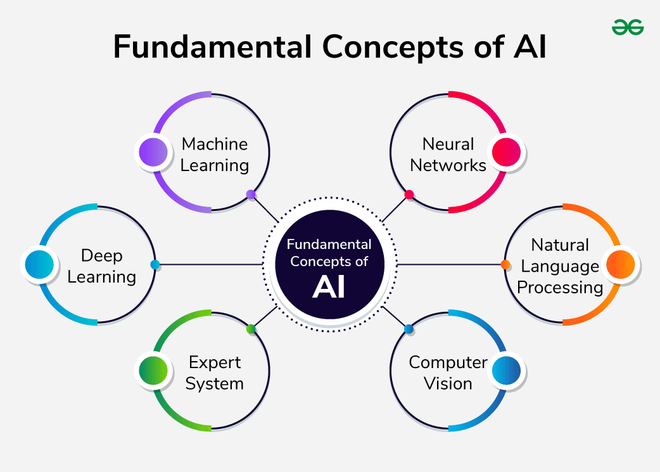
Unlocking the Basics: A Beginner’s Guide to AI Fundamentals & Core Concepts
Welcome to the future! Artificial Intelligence (AI) is no longer just a concept from science fiction; it’s a rapidly evolving field transforming nearly every aspect of our lives. From personalized recommendations on your favorite streaming service to sophisticated medical diagnoses, AI is quietly, yet powerfully, at work.
But what exactly is AI? And how does it work? If you’ve ever felt overwhelmed by the jargon and complex explanations, you’re in the right place. This comprehensive guide will demystify AI, breaking down its fundamental concepts into easy-to-understand language. Whether you’re a curious individual, an aspiring tech enthusiast, or just want to grasp the basics of this revolutionary technology, let’s embark on this exciting journey together.
What Exactly is Artificial Intelligence? A Simple Definition
At its core, Artificial Intelligence (AI) refers to the simulation of human intelligence in machines that are programmed to think and learn like humans. It’s about creating systems that can:
- Understand: Process and interpret information from the world.
- Reason: Solve problems, make decisions, and draw conclusions based on data.
- Learn: Improve their performance over time by analyzing data and experiences.
- Perceive: Interpret sensory information (like images, sounds, and text).
- Act: Perform tasks, whether physical (like a robot) or digital (like a chatbot).
Think of it as giving machines the ability to perform tasks that typically require human intelligence. This isn’t about creating conscious beings (at least not yet!), but rather building sophisticated tools that can automate complex processes, analyze vast amounts of data, and make intelligent decisions.
A Brief History: While AI seems cutting-edge, its roots go back decades. The term "Artificial Intelligence" was coined in 1956 by John McCarthy. Early pioneers like Alan Turing laid the theoretical groundwork, asking questions like "Can machines think?" The field has seen periods of "AI springs" and "AI winters," but recent advancements in computing power, data availability, and algorithm development have led to the current explosion of AI capabilities.
The Pillars of AI: Key Disciplines Explained
AI isn’t a single technology; it’s an umbrella term encompassing several specialized fields. Understanding these core disciplines is crucial to grasping how AI systems are built and what they can achieve.
1. Machine Learning (ML): AI’s Learning Engine
If AI is the brain, then Machine Learning (ML) is the primary way that brain learns. ML is a subset of AI that focuses on enabling systems to learn from data without being explicitly programmed for every possible scenario. Instead of writing rigid rules, you feed an ML model data, and it identifies patterns and makes predictions or decisions based on those patterns.
Imagine teaching a child to identify a cat. You don’t give them a list of rules ("if pointy ears AND whiskers AND meow, then cat"). Instead, you show them many pictures of cats and non-cats, and they gradually learn to distinguish them. ML works similarly.
There are three main types of Machine Learning:
- Supervised Learning:
- How it works: The model learns from labeled data, meaning each piece of data has a corresponding "answer" or "label."
- Analogy: Learning with a teacher. You show the model pictures of cats, and you tell it, "This is a cat."
- Examples: Image classification (is this a dog or a cat?), spam detection (is this email spam or not?), predicting house prices (given features, what’s the price?).
- Unsupervised Learning:
- How it works: The model learns from unlabeled data, finding hidden patterns or structures on its own.
- Analogy: Learning without a teacher. You give the model a pile of animal pictures and ask it to group similar ones together, without telling it what a cat or dog is.
- Examples: Customer segmentation (grouping similar customers for marketing), anomaly detection (finding unusual patterns like fraud), dimensionality reduction.
- Reinforcement Learning (RL):
- How it works: The model learns by trial and error, interacting with an environment and receiving rewards or penalties for its actions.
- Analogy: Learning like training a pet. If the pet does something good, it gets a treat (reward); if it does something bad, it gets no treat (penalty).
- Examples: Training AI for games (like AlphaGo beating the Go world champion), robotics for complex movements, autonomous driving decisions.
2. Deep Learning (DL): Unlocking Deeper Patterns
Deep Learning (DL) is a specialized sub-field of Machine Learning that uses Artificial Neural Networks (ANNs) with multiple "layers" (hence "deep") to learn from vast amounts of data. These neural networks are loosely inspired by the structure and function of the human brain.
- How it works: Data passes through multiple layers of interconnected "neurons." Each layer extracts different features from the data, gradually building a more complex understanding. For example, in an image, one layer might detect edges, another shapes, and a higher layer might identify objects.
- Analogy: Imagine a factory assembly line where each station (layer) refines the product (data) before passing it to the next, leading to a highly sophisticated final output.
- Strengths: Excellent for handling complex, unstructured data like images, audio, and text. Requires massive datasets and significant computing power.
- Examples: Facial recognition, voice assistants (Siri, Alexa), machine translation, self-driving cars.
3. Natural Language Processing (NLP): AI That Understands Language
Natural Language Processing (NLP) is the branch of AI that enables computers to understand, interpret, and generate human language in a valuable way. It bridges the gap between how humans communicate and how computers process information.
- Key Tasks:
- Sentiment Analysis: Determining the emotional tone of text (e.g., positive, negative, neutral reviews).
- Machine Translation: Translating text from one language to another (e.g., Google Translate).
- Text Summarization: Condensing long documents into shorter summaries.
- Chatbots and Virtual Assistants: Understanding and responding to user queries.
- Speech Recognition: Converting spoken language into text.
- Named Entity Recognition: Identifying specific entities like people, organizations, or locations in text.
- Why it’s Hard: Human language is incredibly complex, filled with ambiguity, sarcasm, context, and nuance. NLP aims to teach machines to navigate these complexities.
- Examples: Spam filters, grammar checkers, voice-controlled devices, customer service chatbots.
4. Computer Vision (CV): AI That Sees
Computer Vision (CV) is an AI field that trains computers to "see" and interpret the visual world. It enables machines to understand and process images and videos in the same way humans do.
- Key Tasks:
- Image Classification: Identifying what an image depicts (e.g., "This is a cat").
- Object Detection: Locating specific objects within an image and drawing bounding boxes around them (e.g., "There’s a car and a pedestrian here").
- Facial Recognition: Identifying individuals from their faces.
- Image Segmentation: Dividing an image into segments to make it easier to analyze.
- Activity Recognition: Understanding actions happening in videos.
- How it Works: Often heavily relies on Deep Learning, particularly Convolutional Neural Networks (CNNs), which are excellent at processing pixel data.
- Examples: Self-driving cars (recognizing road signs, other vehicles, pedestrians), medical imaging analysis (detecting tumors), quality control in manufacturing, security surveillance.
5. Robotics: AI in the Physical World
While not solely an AI field, Robotics often heavily integrates AI to give robots the ability to perceive their environment, make decisions, learn, and interact autonomously.
- AI’s Role in Robotics:
- Navigation: Using computer vision and other sensors to map and move through an environment.
- Manipulation: AI-driven grippers and arms to perform delicate tasks.
- Human-Robot Interaction: Using NLP to understand commands and generate responses.
- Learning: Robots learning new tasks or improving existing ones through reinforcement learning.
- Examples: Industrial robots on assembly lines, surgical robots, autonomous drones, humanoid robots, robot vacuum cleaners.
Other Important AI Areas:
- Expert Systems: Early AI systems designed to mimic the decision-making ability of a human expert within a specific domain, using rules and knowledge bases.
- Planning & Scheduling: AI algorithms that determine a sequence of actions to achieve a goal, often used in logistics and operations.
- Reasoning: AI systems that use logic and inference to draw conclusions from available information.
Types of AI: Understanding the Spectrum
AI capabilities are often categorized into three broad types, based on their level of intelligence and functionality:
1. Narrow AI (ANI) / Weak AI
- Definition: This is the only type of AI that currently exists. Narrow AI is designed and trained for a specific, single task or a limited range of tasks. It excels at what it’s built for but cannot perform outside its programmed domain.
- Characteristics:
- Highly specialized.
- Doesn’t possess consciousness or genuine understanding.
- Follows predefined rules or learns patterns within its scope.
- Examples:
- Siri, Alexa, Google Assistant: They understand voice commands and provide information but can’t truly "think" or reason beyond their programmed functions.
- Recommendation Systems: Netflix suggestions, Amazon product recommendations.
- Spam Filters: Classifying emails as spam or not.
- Chess-playing AI: Can beat human grandmasters but can’t drive a car or write a novel.
- Image Recognition Software: Identifying faces or objects in photos.
2. General AI (AGI) / Strong AI / Human-Level AI
- Definition: This is hypothetical AI that possesses the ability to understand, learn, and apply intelligence across a wide range of tasks, just like a human being. It would be able to perform any intellectual task that a human can.
- Characteristics:
- Ability to reason, solve problems, make decisions, learn from experience, and understand complex ideas.
- Possesses common sense and can generalize knowledge from one domain to another.
- Would potentially have consciousness or self-awareness (a highly debated philosophical point).
- Status: AGI does not currently exist. It remains a significant research goal, but its realization is still many decades, if not centuries, away, or perhaps even fundamentally impossible.
- Examples (Hypothetical): A robot that could learn any new skill, engage in meaningful conversations, write a bestselling novel, and conduct scientific research, all simultaneously.
3. Super AI (ASI)
- Definition: Also hypothetical, Super AI would surpass human intelligence and capabilities in virtually every field, including creativity, problem-solving, and general knowledge.
- Characteristics:
- Significantly more intelligent than the smartest human beings.
- Could lead to rapid advancements beyond human comprehension (often referred to as the "intelligence explosion").
- Its potential implications range from solving humanity’s greatest challenges to existential risks.
- Status: Purely theoretical and far beyond current technological capabilities.
- Examples (Hypothetical): An AI that could cure all diseases, solve climate change, and design technologies far more advanced than anything humans have conceived.
How Does AI Learn? The Data-Driven Approach
The "magic" behind AI’s ability to perform intelligent tasks isn’t magic at all; it’s a sophisticated process primarily driven by data.
-
Data is King:
- AI models learn by identifying patterns and relationships within vast amounts of data. This data can be anything: images, text, numbers, audio, videos, sensor readings, etc.
- The quality and quantity of data directly impact the AI’s performance. "Garbage in, garbage out" is a common adage in AI.
- Data often needs to be cleaned, processed, and formatted (this is called "data pre-processing") before it can be fed to an AI model.
-
Algorithms & Models:
- Algorithms are sets of instructions or rules that an AI system follows to achieve a specific task. In ML, algorithms define how the model learns from data (e.g., decision trees, neural networks).
- An AI Model is the outcome of training an algorithm on a dataset. It’s the learned representation of the patterns in the data, ready to make predictions or decisions on new, unseen data.
-
Training & Inference:
- Training Phase: This is where the AI model "learns." The algorithm processes the training data, adjusting its internal parameters (like weights in a neural network) to minimize errors and identify patterns. This process can take hours, days, or even weeks for complex models and large datasets.
- Inference Phase: Once trained, the model is ready to be used. In this phase, it takes new, unseen data and applies its learned knowledge to make predictions or decisions. For example, a trained image recognition model takes a new photo and identifies objects within it.
Why AI Matters: Real-World Applications (and Benefits)
AI is not just a niche technology; it’s a general-purpose technology with the potential to impact virtually every industry and aspect of daily life. Here are just a few examples:
- Healthcare:
- Disease Diagnosis: AI analyzes medical images (X-rays, MRIs) to detect anomalies like tumors, often with greater accuracy than human eyes.
- Drug Discovery: Accelerating the identification of new drug compounds.
- Personalized Medicine: Tailoring treatments based on a patient’s genetic makeup and health data.
- Finance:
- Fraud Detection: Identifying unusual transaction patterns to flag potential fraud.
- Algorithmic Trading: AI-powered systems making rapid trading decisions in financial markets.
- Credit Scoring: Assessing creditworthiness with higher accuracy.
- Retail & E-commerce:
- Recommendation Engines: Suggesting products based on past purchases and browsing history.
- Personalized Marketing: Tailoring ads and promotions to individual customers.
- Inventory Management: Optimizing stock levels and predicting demand.
- Transportation:
- Autonomous Vehicles: Self-driving cars, trucks, and drones using AI for navigation, perception, and decision-making.
- Traffic Management: Optimizing traffic flow and reducing congestion.
- Education:
- Personalized Learning: Adapting teaching methods and content to individual student needs.
- Automated Grading: Assisting teachers with grading assignments.
- Customer Service:
- Chatbots & Virtual Assistants: Providing instant support and answering common queries.
- Call Center Automation: Routing calls and assisting human agents.
- Entertainment:
- Content Recommendation: Movies, music, and news suggestions.
- AI-Generated Content: Creating music, art, and even scripts.
- Manufacturing:
- Predictive Maintenance: Identifying potential equipment failures before they occur.
- Quality Control: AI vision systems inspecting products for defects.
Navigating the Future: Challenges & Ethical Considerations
While AI offers immense promise, it also presents significant challenges and ethical dilemmas that need careful consideration as the technology advances:
- Bias in AI: AI systems learn from data. If the data reflects societal biases (e.g., historical discrimination), the AI can perpetuate or even amplify those biases in its decisions.
- Privacy Concerns: AI often requires vast amounts of personal data, raising questions about data security, usage, and consent.
- Job Displacement: Automation powered by AI could lead to job losses in certain sectors, necessitating retraining and new economic models.
- Accountability & Transparency: When an AI makes a critical decision, who is responsible? And can we understand why it made that decision ("explainable AI")?
- Security Risks: AI systems can be vulnerable to attacks, such as "adversarial attacks" that trick them into making incorrect classifications.
- The Future of AGI/ASI: While distant, the potential societal impact of highly intelligent AI systems raises profound questions about control, values, and humanity’s role.
Addressing these challenges requires ongoing research, thoughtful policy-making, ethical guidelines, and broad societal discussion.
Conclusion: Your Journey into AI Has Just Begun
Artificial Intelligence is a transformative force that is redefining industries, creating new opportunities, and challenging our understanding of intelligence itself. By understanding the fundamentals – from what AI is, to its core disciplines like Machine Learning and Deep Learning, and the different types of AI – you’ve taken a crucial first step in navigating this exciting landscape.
Remember, AI is not a single, magical entity but a collection of powerful tools and techniques designed to augment human capabilities. As AI continues to evolve, a basic understanding of its principles will become increasingly valuable for everyone, regardless of their profession. The future is intelligent, and now you have a foundational understanding to be a part of it.
Frequently Asked Questions (FAQs) About AI Fundamentals
Q1: Is AI just for tech experts?
A1: Not at all! While developing AI requires specialized skills, understanding its concepts and applications is becoming essential for everyone. Just like you don’t need to be an automotive engineer to drive a car, you don’t need to be an AI researcher to benefit from and understand AI’s impact.
Q2: What’s the difference between AI and Machine Learning (ML)?
A2: AI is the broader concept of machines performing tasks that require human intelligence. Machine Learning is a subset of AI, a specific method that enables AI systems to learn from data without explicit programming. Think of it this way: all ML is AI, but not all AI is ML (e.g., older rule-based AI systems were not ML).
Q3: Will AI take all our jobs?
A3: This is a complex and frequently asked question. While AI will certainly automate many routine or repetitive tasks, it’s more likely to transform jobs than completely eliminate them. AI is expected to create new jobs that require human skills like creativity, critical thinking, emotional intelligence, and collaboration. The key will be adapting to these changes through lifelong learning and skill development.
Q4: How can I start learning more about AI?
A4: There are many excellent resources!
- Online Courses: Platforms like Coursera, edX, Udacity, and Khan Academy offer introductory AI and ML courses.
- Books: Many beginner-friendly books explain AI concepts without heavy math.
- Blogs & Articles: Follow reputable tech news sites and AI research blogs.
- Podcasts: Listen to podcasts that discuss AI news and breakthroughs.
- Hands-on Projects: Once you grasp the basics, try simple coding projects using AI libraries like TensorFlow or PyTorch (Python is a popular language for AI).
Q5: Is AI conscious or emotional?
A5: Currently, no. The AI systems we have today (Narrow AI) are sophisticated algorithms and models that simulate intelligent behavior. They do not possess consciousness, self-awareness, emotions, or genuine understanding in the human sense. These are highly complex philosophical and scientific questions that are far from being answered in the context of AI.



Post Comment